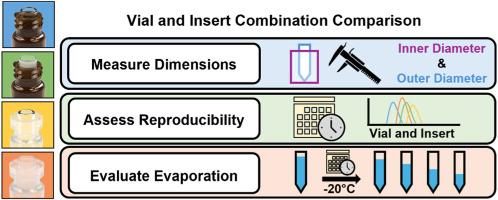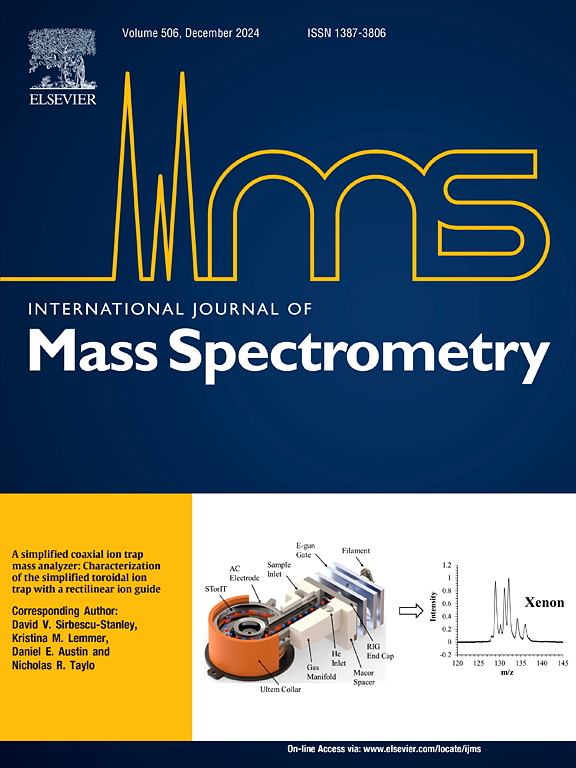选择正确的自动进样器小瓶和插入物,以提高质谱分析的再现性和准确性
IF 1.7
3区 化学
Q3 PHYSICS, ATOMIC, MOLECULAR & CHEMICAL
引用次数: 0
摘要
获得准确和可重复的数据对于分析化学家来说至关重要,然而,样品存储和操作在获得高质量结果中起着重要作用。在质谱分析之前,自动进样器小瓶和小体积插入物用于样品制备和存储,然而,这些工具的实用性、设计和材料差异很大。在这里,我们评估了由玻璃和聚丙烯制成的小瓶和插入物在数据可重复性、样品损失和物理差异方面的差异,这些小瓶和插入物用于组合(小瓶/插入物):玻璃/玻璃(GG)、玻璃/聚丙烯(GP)、聚丙烯/玻璃(PG)和聚丙烯/聚丙烯(PP)。六种全氟烷基和多氟烷基物质(PFAS)在40:60的甲醇:水和3mm醋酸铵中进行了32天的评估,以确定随着时间的推移峰面积的再现性,因为PFAS不会降解,因此变化很可能是由于粘附和蒸发。在第1天,6种PFAS的测量平均峰面积在任何组合之间均无统计学意义,但PP的可重复性最低(相对标准偏差>;10%)。然后将所有样品在- 20°C下重新封装并保存一个月,并重新分析以比较第1天至第32天之间的峰面积。所有组合在至少4种PFAS的峰面积上显示出10%的差异,并且观察到蒸发和粘附。而最大的影响,由于粘附发生在玻璃插入,玻璃小瓶显示最小的体积损失蒸发。因此,当粘附和蒸发一起考虑时,推荐GP组合用于PFAS分析,因为玻璃小瓶减少蒸发速率,聚丙烯插入物最大限度地减少粘附。本文章由计算机程序翻译,如有差异,请以英文原文为准。

Selecting the correct autosampler vial and insert to improve reproducibility and accuracy in mass spectrometry analyses
Acquiring accurate and reproducible data is crucial for analytical chemists, however, sample storage and manipulation play a large role in achieving high-quality results. Autosampler vials and small-volume inserts are used for sample preparation and storage prior to mass spectrometry analyses, however, the utility, design, and material of these vary greatly. Here, we assessed differences in data reproducibility, sample loss, and physical differences among vials and inserts made of glass and polypropylene for combinations (vial/insert): glass/glass (GG), glass/polypropylene (GP), polypropylene/glass (PG), and polypropylene/polypropylene (PP). Six per- and polyfluoroalkyl substances (PFAS) were evaluated in 40:60 methanol:water with 3 mM ammonium acetate for 32 days to determine peak area reproducibility over time since PFAS do not degrade, therefore changes would most likely be due to adhesion and evaporation. On Day 1, the measured average peaks areas for the 6 PFAS were not statistically significant between any combinations, however, PP was the least reproducible (relative standard deviation > 10 %). All samples were then recapped and stored for one month at −20 °C and reanalyzed to compare the peak areas between Day 1 to Day 32. All combinations showed >10 % differences in peak area for at least 4 PFAS and both evaporation and adhesion were observed. While the greatest effects due to adhesion occurred in the glass inserts, the glass vials showed the least volume loss to evaporation. Thus, when adhesion and evaporation are considered together, the GP combination is recommended for PFAS analyses as the glass vial reduces evaporation rates, and the polypropylene insert minimizes adhesion.
求助全文
通过发布文献求助,成功后即可免费获取论文全文。
去求助
来源期刊
CiteScore
3.60
自引率
5.60%
发文量
145
审稿时长
71 days
期刊介绍:
The journal invites papers that advance the field of mass spectrometry by exploring fundamental aspects of ion processes using both the experimental and theoretical approaches, developing new instrumentation and experimental strategies for chemical analysis using mass spectrometry, developing new computational strategies for data interpretation and integration, reporting new applications of mass spectrometry and hyphenated techniques in biology, chemistry, geology, and physics.
Papers, in which standard mass spectrometry techniques are used for analysis will not be considered.
IJMS publishes full-length articles, short communications, reviews, and feature articles including young scientist features.

 求助内容:
求助内容: 应助结果提醒方式:
应助结果提醒方式:


